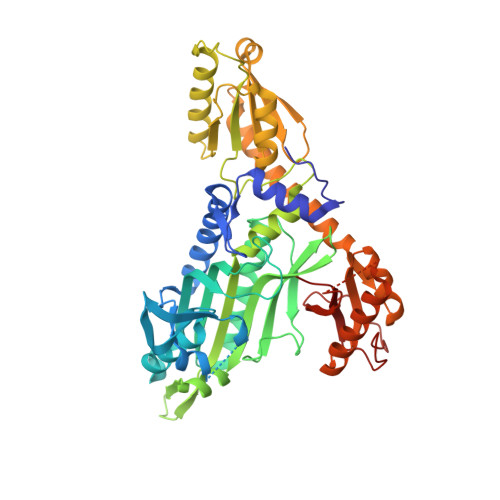Conformational heterogeneity in apo and drug-bound structures of Toxoplasma gondii prolyl-tRNA synthetase.
Mishra, S., Malhotra, N., Kumari, S., Sato, M., Kikuchi, H., Yogavel, M., Sharma, A.(2019) Acta Crystallogr F Struct Biol Commun 75: 714-724
- PubMed: 31702585
- DOI: https://doi.org/10.1107/S2053230X19014808
- Primary Citation of Related Structures:
6A88, 6AA0 - PubMed Abstract:
Prolyl-tRNA synthetase (PRS) is a member of the aminoacyl-tRNA synthetase family that drives protein translation in cells. The apicomplexan PRSs are validated targets of febrifugine (FF) and its halogenated derivative halofuginone (HF). PRSs are of great interest for drug development against Plasmodium falciparum and Toxoplasma gondii. In this study, structures of apo and FF-bound T. gondii (TgPRS) are revealed and the dynamic nature of the conformational changes that occur upon FF binding is unraveled. In addition, this study highlights significant conformational plasticity within two different crystal structures of apo PRSs but not within drug-bound PRSs. The apo PRSs exist in multi-conformational states and manifest pseudo-dimeric structures. In contrast, when FF is bound the PRS dimer adopts a highly symmetrical architecture. It is shown that TgPRS does not display extant fold switching, in contrast to P. falciparum PRS, despite having over 65% sequence identity. Finally, structure-comparison analyses suggest the utility of r.m.s.d. per residue (r.m.s.d. /res ) as a robust tool to detect structural alterations even when the r.m.s.d. is low. Apo TgPRS reveals FF/HF-induced rigidity and this work has implications for drug-design studies that rely on the apo structures of target proteins.
Organizational Affiliation:
Structural Parasitology, International Centre for Genetic Engineering and Biotechnology, New Delhi, Aruna Asaf Ali Marg, New Delhi, Delhi 110067, India.

















